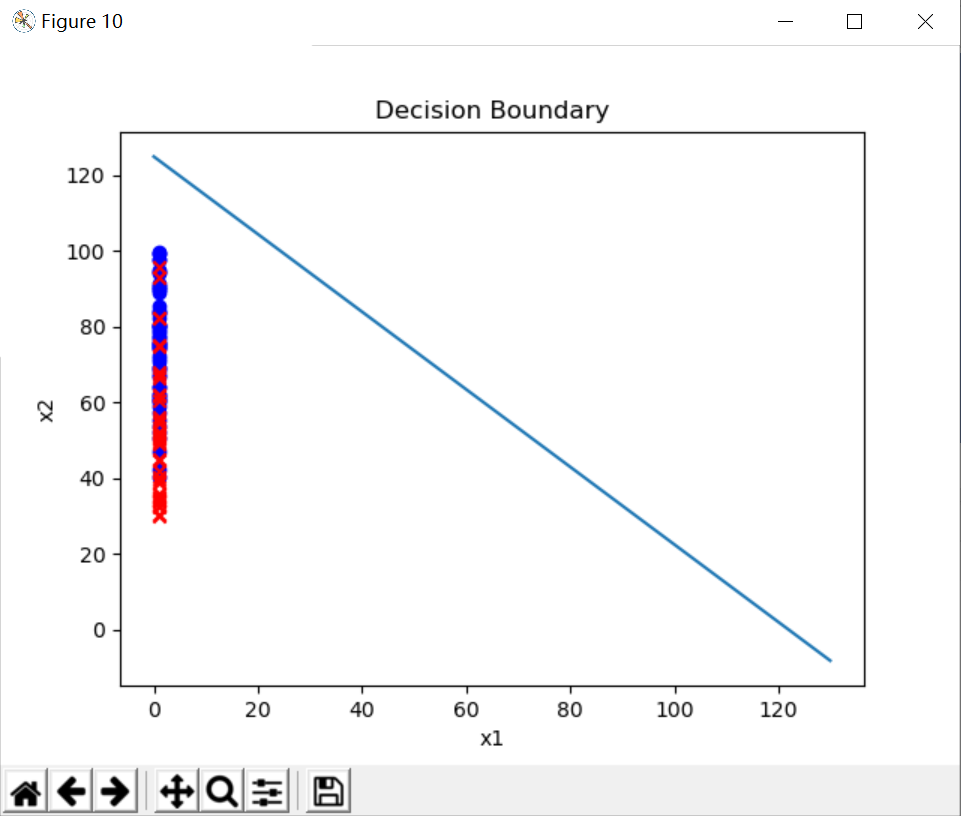吴恩达机器学习第二章作业:线性回归,TASK1 逻辑回归(python实现)
TASK 1任务要求:实现预测学生被录取的几率。
数据集:现在有100名学生的数据集,col1 是考试一的分数,col2 是考试二的分数,col3 是该学生是否被录取
1、实现数据的可视化
data = pd.read_csv('D:\python学习\吴恩达机器学习\ex2data1.txt',header=None,names=['subject1','subject2','admit']) X = data.iloc[:,0:-1] # DataFrame用iloc取列 y = data.iloc[:,-1] X = X.values y = y.values plt.figure(10) ax = plt.subplot() ax.scatter(X[y==1,0],X[y==1,1],marker='o',c='b') ax.scatter(X[y==0,0],X[y==0,1],marker='x',c='r') plt.show()
这个上一个稿件也说明了怎么样使数据可视化,现在不再赘述。只是倒数第二行和倒数第三行的散点图的绘制要学习一下!
绘制效果如图:

2、实现sigmoid函数(也就是s型函数)
def sigmoid(z): return 1 / (1 + np.exp(- z))
3、计算初始时的cost的值是多少
再定义一个函数:
def computecost(theta, x, y): first = (-y) * np.log(sigmoid(x @ theta)) #cost函数前面的项 @是矩阵乘法 second = (1 - y)*np.log(1 - sigmoid(x @ theta)) #cost函数后面的项 return np.mean(first - second) # 求均值
cost = 0.6931471805599453
4、计算梯度:(因为在这个例子里面梯度不能和优化一起跟新theta,所以只能先算梯度,后算优化)
def gradient(theta, x, y): return (x.T @ (sigmoid(x @ theta) - y))/len(x)
5、进行优化,我们优化不必像前一个例子一样自己手动计算theta之后跟新的值,我们可以借助优化函数:
result = opt.fmin_tnc(func=computecost, x0=theta, fprime=gradient, args=(x, y)) #func:优化的目标函数 fprime:梯度函数 args:数据 x0 初值
最后得到的result时一个array,我们要将他变为向量;采用final_theta = result[0],来使array变成向量
最后得到的向量为:
final_theta = [-25.16131846 0.20623159 0.20147148]
代表了theta0(偏置),theta1(x1的权重),theta2(x2的权重)
6、绘制决策边界:
x1 = np.arange(130, step=0.1) x2 = -(final_theta[0]+final_theta[1]*x1)/final_theta[2] plt.figure(10) ax = plt.subplot() ax.scatter(x[y==1,0],x[y==1,1], color='blue', marker = 'o') ax.scatter(x[y==0,0],x[y==0,1], color='red', marker='x') ax.plot(x1, x2) ax.set_xlabel('x1') ax.set_ylabel('x2') ax.set_title('Decision Boundary') plt.show()
先规定x1的范围,然后再通过公式:theta0 + theta1*x1 + theta2*x2 = 0来解出 x2 = -(theta0+theta1*x1)/ theta2
然后再画出决策边界,如下图:

最后的散点图没有能绘制好,我尝试的所有办法都不能让exam1score的分数从 x1 = 1 的这个线移开,但是决策边界已经写好了,TASK1也就完成了。
最后附上所有的代码:
import numpy as np import pandas as pd import matplotlib.pyplot as plt import scipy.optimize as opt data = pd.read_csv('D:\python学习\吴恩达机器学习\ex2data1.txt',header=None,names=['subject1','subject2','admit']) x = data.iloc[:,0:-1] # DataFrame用iloc取列 y = data.iloc[:,-1] x = x.values y = y.values theta = np.zeros(x.shape[1]) #设定theta初始值为0 plt.figure(10) ax = plt.subplot() ax.scatter(x[y==1,0],x[y==1,1],marker='o',c='b') ax.scatter(x[y==0,0],x[y==0,1],marker='x',c='r') plt.show() def sigmoid(z): return 1 / (1 + np.exp(- z)) def computecost(theta, x, y): first = (-y) * np.log(sigmoid(x @ theta)) #cost函数前面的项 @是矩阵乘法 second = (1 - y)*np.log(1 - sigmoid(x @ theta)) #cost函数后面的项 return np.mean(first - second) # 求均值 print(computecost(x,y,theta)) def gradient(theta, x, y): return (x.T @ (sigmoid(x @ theta) - y))/len(x) data = pd.read_csv('D:\python学习\吴恩达机器学习\ex2data1.txt', names=['exam1', 'exam2', 'admitted'])# 读入数据 标记列名 #接下来预测学生是否被录取,写决策边界 def predict(theta,x): h_theta = sigmoid(x @ theta) return [1 if x>=0.5 else 0 for x in h_theta] data.insert(0, 'Ones', 1) # 在data中加一列x0 x = data.iloc[:,0:-1] # DataFrame用iloc取列 y = data.iloc[:,-1] x = x.values y = y.values theta = np.zeros(x.shape[1]) #设定theta初始值为0 result = opt.fmin_tnc(func=computecost, x0=theta, fprime=gradient, args=(x, y)) #func:优化的目标函数 fprime:梯度函数 args:数据 x0 初值 final_theta = result[0] print(final_theta) #predictions = predict(final_theta,x) #correct = [1 if a==b else 0 for (a,b) in zip (predictions,y)] #accuracy = sum(correct)/len(x) #print(accuracy) #绘制决策边界 x1 = np.arange(130, step=0.1) x2 = -(final_theta[0]+final_theta[1]*x1)/final_theta[2] plt.figure(10) ax = plt.subplot() ax.scatter(x[y==1,0],x[y==1,1], color='blue', marker = 'o') ax.scatter(x[y==0,0],x[y==0,1], color='red', marker='x') ax.plot(x1, x2) ax.set_xlabel('x1') ax.set_ylabel('x2') ax.set_title('Decision Boundary') plt.show()

